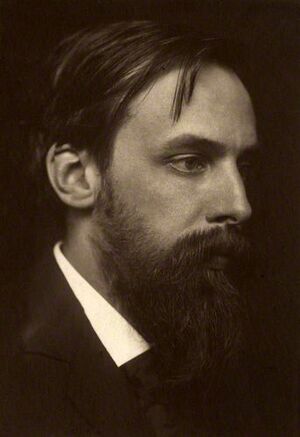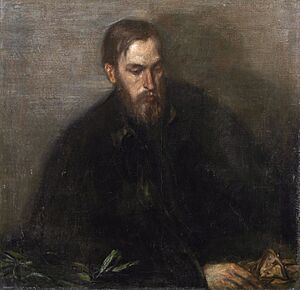Thomas Sturge Moore facts for kids
Quick facts for kids
Thomas Sturge Moore
|
|
|---|---|

Thomas Sturge Moore
by George Charles Beresford, 1903 |
|
| Born | 4 March 1870 3 Wellington Square, Hastings, East Sussex |
| Died | 18 July 1944 St Andrews Cottage, Clewer, Windsor, Berkshire |
| Resting place | Ashes scattered near Petersfield, Hampshire |
| Occupation | Poet, writer and artist |
| Education | Dulwich College Croydon School of Art Lambeth School of Art |
| Genre | Georgian Poetry Noh drama Art nouveau Art deco |
| Spouse | Marie Appia (1872–1956) |
| Children | Daniel Sturge-Moore (1908–1980) Riette Sturge-Moore (1907–1995) |
| Relatives | G.E. Moore (brother) Nicholas Moore (nephew) |
Thomas Sturge Moore (born March 4, 1870 – died July 18, 1944) was a talented British poet, writer, and artist. He was known for his beautiful poetry and his skills as a wood-engraver. He also designed book covers and wrote plays.
Contents
About Thomas Sturge Moore
Thomas Sturge Moore was born in Hastings, East Sussex, on March 4, 1870. He went to school at Dulwich College. He also studied art at the Croydon School of Art and Lambeth School of Art. At Lambeth, he learned from Charles Roberts, who was an expert in wood-engraving.
His Friendships and Plays
Sturge Moore was a close friend of the famous Irish poet W. B. Yeats. Yeats once said that Moore was "one of the most exquisite poets writing in England." Besides poetry, Moore also wrote plays. One of his plays, Medea, was inspired by Yeats's work and the Japanese Noh style of drama. Noh is a traditional Japanese musical drama.
As an artist, Sturge Moore designed covers for poetry books by Yeats and other writers. He also created illustrations for books published by the Vale Press.
His Poetry and Style
Sturge Moore wrote a lot of poetry. His poems often explored ideas about right and wrong, art, and the human spirit. The poet and critic Yvor Winters described his writing style as "severely classical." This means his poems were very structured and formal.
His first small collection of poems, Two Poems, was printed in 1893. His first full book of poems, The Vinedresser, came out in 1899. He loved poetry so much that he became an active member of the Poetry Recital Society. This group helped people enjoy and share poetry.
The Literary Theatre Club
In 1901, Sturge Moore joined with Yeats, Laurence Binyon, Charles Ricketts, and others to create the Literary Theatre Club. This club aimed to put on new plays. Moore's play, Aphrodite against Artemis, was the very first play performed by the club. Yeats called it "powerful with a beautiful constrained passion."
Later Life and Recognition
In 1913, Moore suggested that Rabindranath Tagore, a famous Indian poet, should receive the Nobel Prize in literature. Tagore later won the prize.
In 1920, Sturge Moore received a special payment called a civil list pension. This was £75 each year, given to him because of his important contributions to literature. In 1930, he was considered for the role of Poet Laureate. This is a special poet who writes poems for national events.
Sturge Moore had health problems for many years. He passed away on July 18, 1944, at a care home in Clewer, Windsor, Berkshire. He was cremated, and his ashes were scattered near Petersfield.
His Family Life
Sturge Moore used his middle name, 'Sturge', as part of his last name. He did this to avoid being confused with another poet named Thomas Moore. 'Sturge' was his mother's family name.
On November 26, 1903, Thomas Sturge Moore married Marie Appia. Marie was the niece of Louis Appia, who helped start the International Committee of the Red Cross. She was also a cousin of the Swiss stage designer Adolphe Appia.
Thomas and Marie had two children:
- Daniel Sturge-Moore, who became a journalist and broadcaster.
- Henriette Sturge-Moore, who was a well-known theatre designer, teacher, and interior decorator.
Sturge Moore was also the brother of George Edward Moore, a famous philosopher. He was the uncle of Nicholas Moore, a poet from the 1940s, and Timothy Moore, a composer.
His Published Works
Here are some of the books and plays written by Thomas Sturge Moore:
- Two Poems, 1893
- The Vinedresser and Other Poems, 1899
- The Centaur and the Bacchant. From the French by Maurice de Guerin, 1899
- Altdorfer, 1900
- Aphrodite Against Artemis, 1901 (a play)
- Absalom, 1903 (poems)
- Danäe, 1903 (poems)
- Durer, 1904
- The Little School, 1905 (poems)
- Poems, 1906
- Correggio, 1906
- Art and Life (Flaubert and Blake), 1910
- Mariamne, 1911 (poems)
- A Sicilian Idyll and Judith: A Conflict, 1911 (a play)
- The Sea is Kind, 1914 (a collection of 69 poems)
- The Wilderness, 1915 (a poetic drama)
- Medea, 1920 (a play)
- Tragic Mothers: Medea, Niobe, Tyrfing, 1920 (a play)
- Mystery and Tragedy: Two Dramatic Poems, 1930 (a play)
- Nine Poems, 1930
- Wind's Work (a poem)
See also


